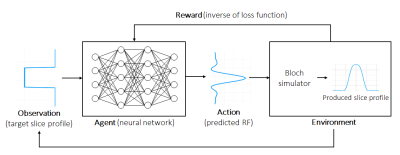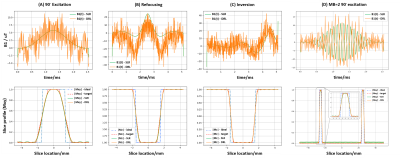Xiaodong Ma1, Kamil Uğurbil1, and Xiaoping Wu1
1Center for Magnetic Resonance Research, Radiology, Medical School, University of Minnesota, Minneapolis, MN, United States
1Center for Magnetic Resonance Research, Radiology, Medical School, University of Minnesota, Minneapolis, MN, United States
We expand the application of a deep reinforcement learning (DRL) pulse design framework to designing basic RF pulses and multi-band pulses. The DRL framework can be used to effectively design all types of RF pulses, improving slice profiles with reduced ripple in comparison to SLR.

Fig.1. The deep reinforcement learning (DRL)
pulse design framework. In a forward pass, the neural network takes the input
target slice profile and outputs the predicted RF pulse. The Bloch simulator
embedded in the system gives the produced slice profile, which in turn is used
(along with the target slice profile) to evaluate the loss. In a backward pass,
the gradient of the loss with respect to the weights of the neural network are
calculated using backpropagation to update the neural network. The procedures
described above are iterated during the training.

Fig.5. Comparison of the SLR algorithm vs our
DRL method when used to design (A) 90◦
excitation, (B) refocusing, (C) inversion and (D) 90◦ excitation multiband (MB=2, gap=50 mm)
pulses. For each scenario a separate neural network was trained. Note that
despite larger fluctuation observed in the predicted RF pulse, our DRL method
led to visually comparable slice profiles for refocusing and inversion, while
improving slice profiles for single band and multiband excitation pulses with
noticeable suppression of stopband ripples.